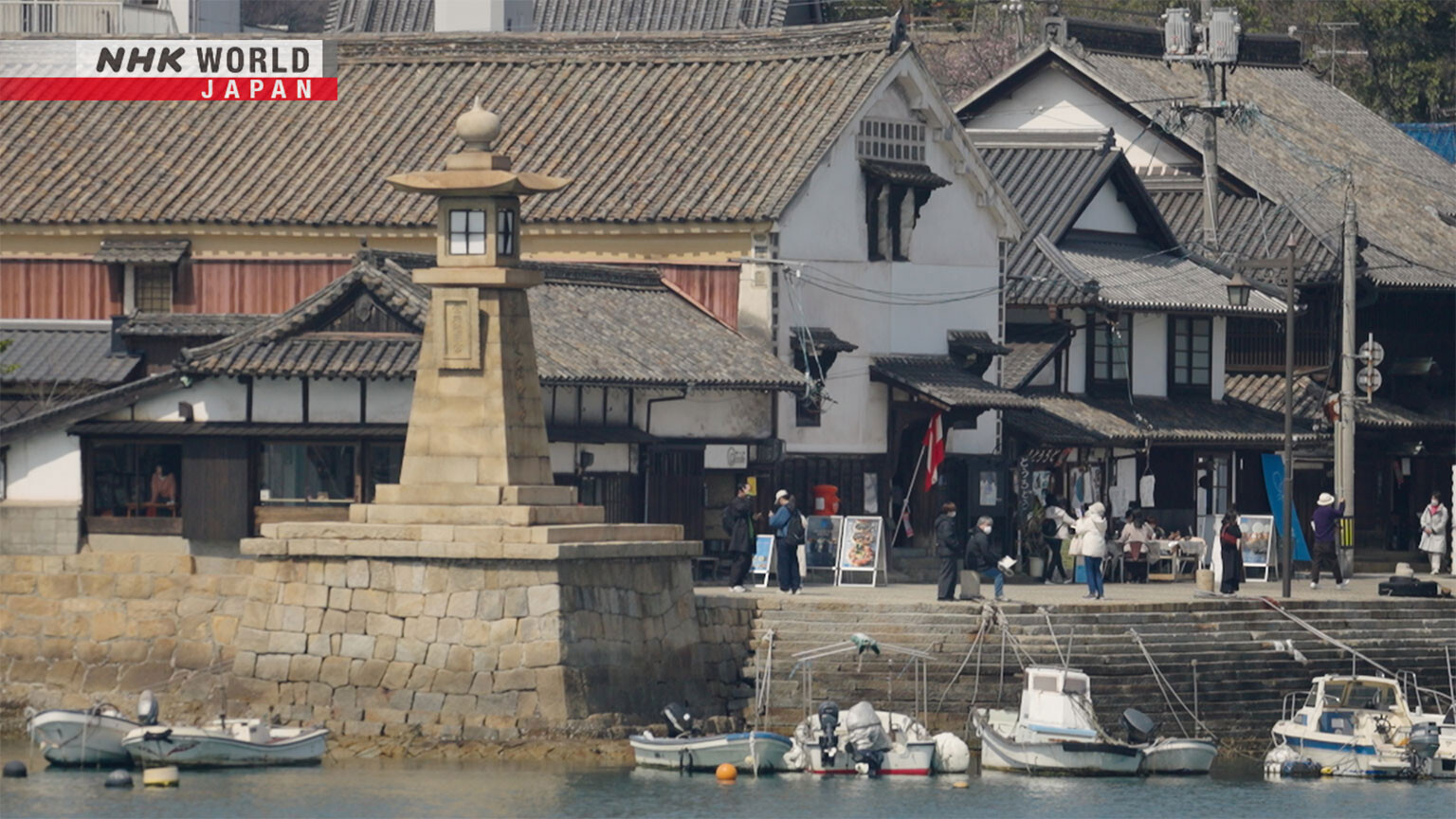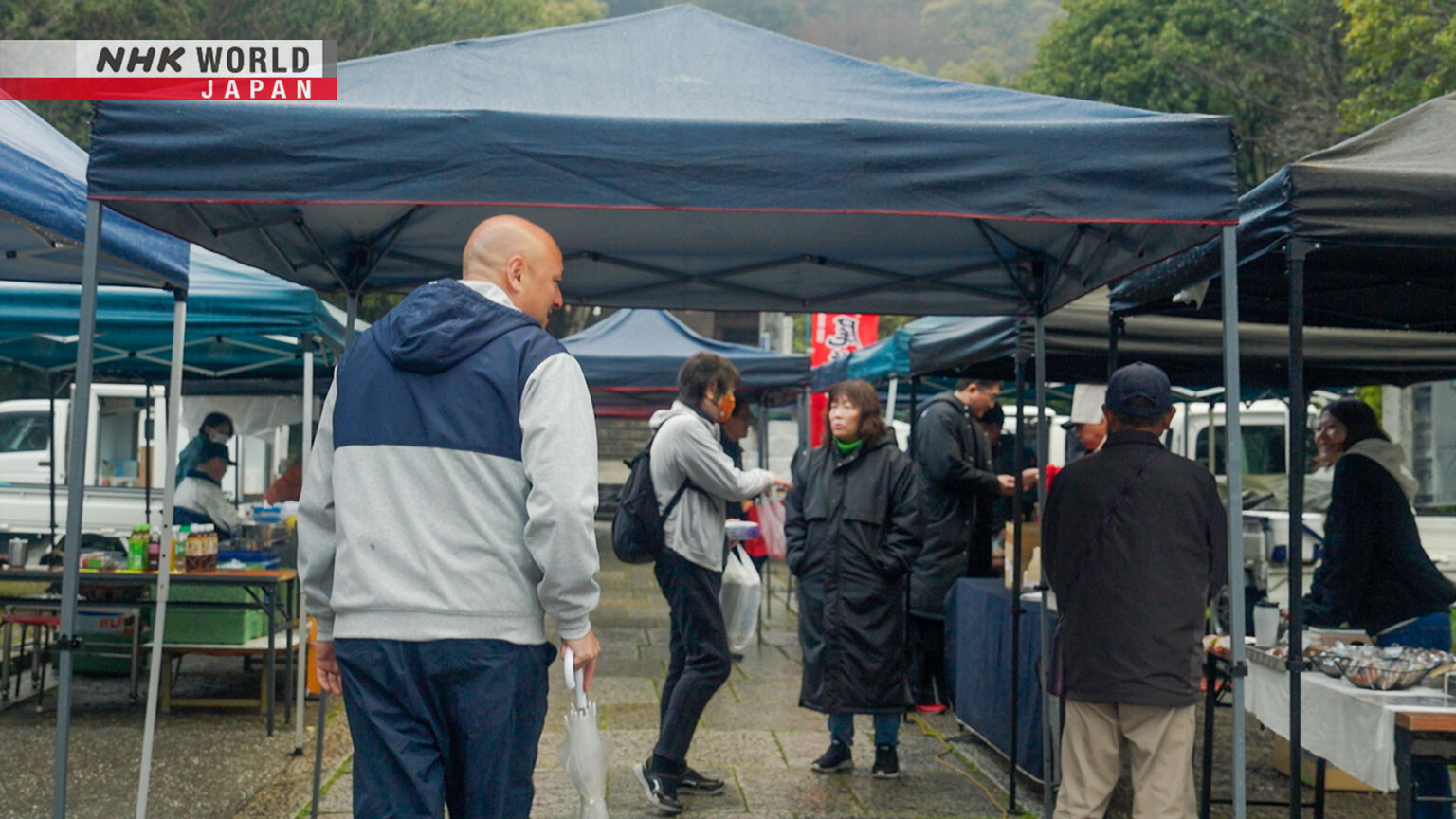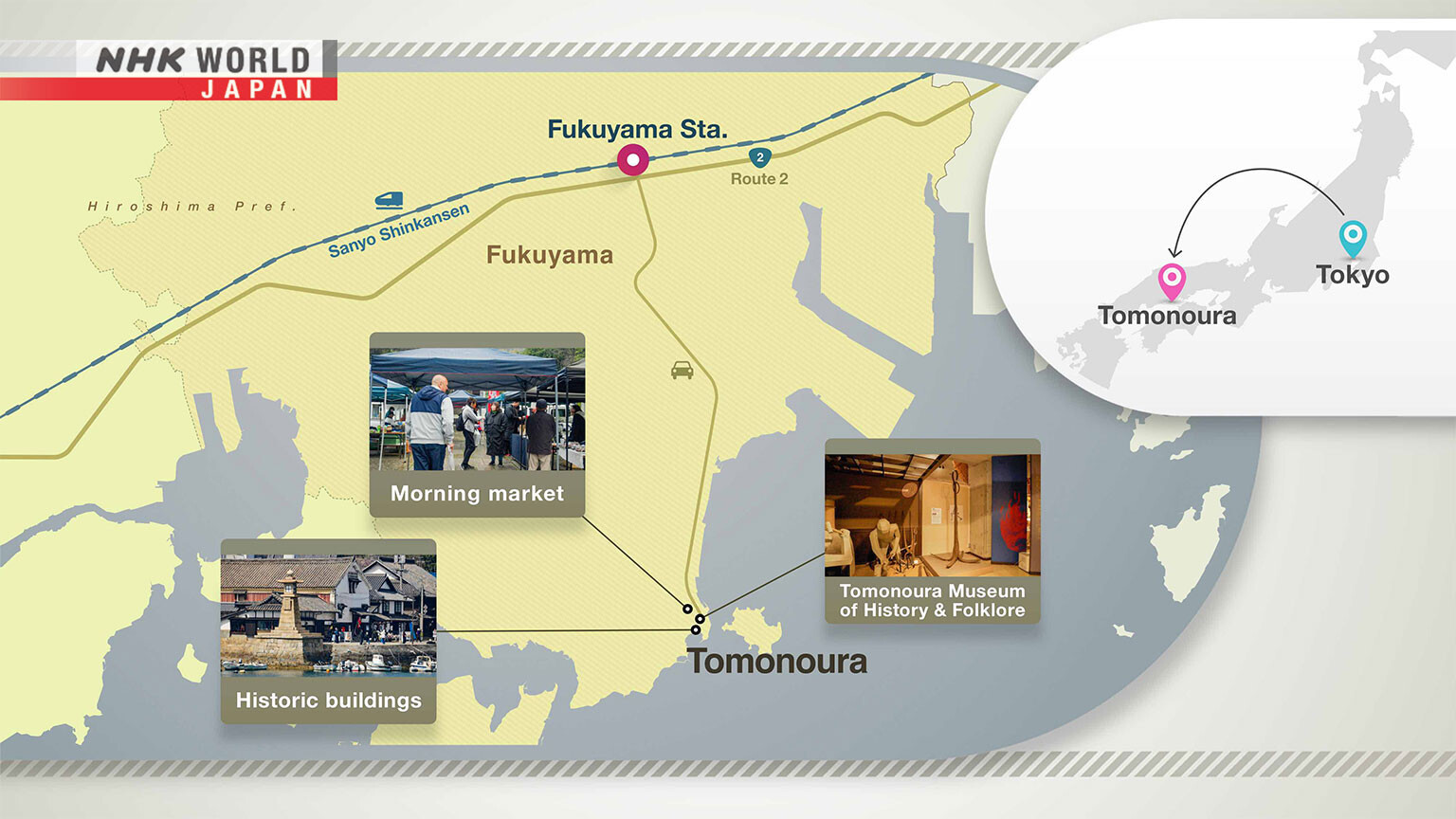Tomonoura: Tradition and Community in a Historic Port
Tomonoura is a port town on the coast of the Seto Inland Sea, in Hiroshima Prefecture. It occupies an important location because this is the point where the tides from each end of the Inland Sea meet. In the old days, ships had to wait here until the ebb tide, before continuing their journeys. For that reason it became known as "the port for awaiting the tide" and was even mentioned in the Manyoshu, a collection of Japanese poems collated some 1,200 years ago. Tom Miyagawa Coulton is a photographer who lives on an island in the Seto Inland Sea. On this episode of Journeys in Japan, Tom explores the historic town of Tomonoura and discovers the town's centuries-old tradition of forging steel. He also meets the local people who have protected this town and kept their community ties with love and care.
Preservation District for Historic Buildings

The Nishimachi district of Tomonoura boasts many traditional buildings dating from the 19th to the early 20th century. In 2017, the area was designated by the government as an Important Preservation District for Groups of Traditional Buildings.
Tomonoura Museum of History and Folklore

This museum introduces the history and culture of the Setouchi region, focusing on the town of Tomonoura, which has prospered since the 8th century.
Minitruck Market

This morning market is held at the Nunakuma Shrine on the fourth Sunday of each month.
Access

To reach Tomonoura from Tokyo, it takes about 3 hours 40 minutes by Shinkansen to Fukuyama Station. From there, buses reach Tomonoura in 30 minutes.
Transcript
"Journeys in Japan"
So I'm here in Tomonoura in the Seto Inland Sea.
This place has a history stretching back over 1,000 years.
And as you can see, it's so peaceful here.
Tom Miyagawa Coulton is a documentary photographer from Britain.
He lives on an island in the Seto Inland Sea.
It feels so calm and peaceful here.
This is actually the second time I've been to Tomonoura.
There's so much here to see and do.
So come with me and let's discover the best of Tomonoura.
Tom has come to look around this port town that has roots dating back around 1,200 years.
He explores some of the historic buildings,
and discovers traditions that date back for centuries.
This is magnificent. Looks like it was made yesterday.
On this edition of "Journeys in Japan,"
Tom gets to meet the people of Tomonoura,
who have protected their town and kept their community ties with love and care.
Oh wow, what a view!
Tomonoura
Tradition and Community in a Historic Port
Tomonoura lies in Hiroshima Prefecture,
about 720 kilometers west of Tokyo.
It overlooks the Seto Inland Sea in the south of Fukuyama City.
It's a strategic location,
because this is the point where the tides from each end of the Inland Sea meet.
Ships had to wait here until the ebb tides to continue their journeys.
Many of the historic buildings have been preserved,
and the port looks a lot like it did in its heyday.
So this area has been designated as a historical preservation district.
And you can see all of these beautifully preserved buildings
wherever you go inside Tomonoura.
Oh wow. What's this place?
Oh wow. This is fantastic.
So you've got all these little products here.
Little kind of maritime themed products.
Oh gosh, that's a glass float.
It looks like we've got little kind of souvenir floats made of glass as well.
These are really cute.
Welcome!
- You have many things related to ships.
- This is a marine supplies store.
Although we do stock some souvenirs, we mainly sell paint, ropes and things like that.
- This shop must have been built a long time ago.
- Yes.
I married into this family over 60 years ago. At that time, it was already 300 years old.
- So it's over 360 years old?
- That's right.
Amazing.
The beams are still alive.
See the glistening thing up there? That's pine resin.
In summer, as the temperature rises, the resin expands.
The wood is still alive. If it weren't living, we couldn't live here.
- This must be hard to maintain.
- It's a lot of work.
My husband has died and his ancestors, too. So it's my responsibility to protect the shop.
We want to pass on many things, as a message to future generations.
In the old days, Tomonoura was known as "the port for awaiting the tide."
It was a stopping point for the Kitamae trading ships
and even for the vessels that carried foreign dignitaries.
As the port grew, the town also flourished as a center for producing the tools used on board ships.
Take a look at this anchor.
It's massive.
It dates from the late Edo period or early Meiji era.
It was made by the "Tomo forging" process.
What does "Tomo forging" mean?
That was the traditional industry in Tomonoura. In the old days, it was big business here.
Do you see the metal layers in the anchor?
It was made by repeated pounding and layering. That forging process makes the steel stronger.
Tomonoura had the highest production in Japan.
That's a lot of layers.
Similar types of anchors are found all over Japan. Tomo forging was that well known.
The techniques for producing anchors were developed from the tradition of forging swords.
So I'm wearing this mask because we're just about to see something very valuable.
This short sword was produced by Tomo forging in the 1400s. It's a blade of the highest quality.
What is interesting is the inscription on the core, which says it was forged in Tomonoura.
This is magnificent. Looks like it was made yesterday.
It's a thing of beauty.
Even 600 years later, it still has a beautiful gleam.
This sword was created as a result of the advanced techniques of Tomo forging.
Tomonoura has many companies that still carry on the tradition of Tomo forging.
It's the foundation of this manufacturing town.
(Tomonoura Blacksmith Town)
So I'm here now in the steel area of Tomonoura.
So it seems like I can experience a traditional Tomonoura forging workshop inside this building.
Let's go inside.
Welcome to our factory.
Thank you. I'm Tom.
We produce a range of items by heating and pounding the steel repeatedly.
We use the traditional method for forging ship anchors.
We heat and hammer five separate parts and then join them. After that we pound and stretch it, to make this shape.
These are the kind of items you can make today.
- I'd like to make a frying pan.
- Of course. That's the most popular item.
The first step in the process is to heat the steel to 1,000 degrees Celsius.
OK, let's start. Hit this part.
Very good.
Next, hammer over here.
I think after learning about Tomonoura's history,
it's really amazing to be able to make this yourself,
and then you can take part of that history back home with you. So it's great.
- It looks good to me.
- Yes, it does.
Well, it's amazing. So this is the final... piece here.
That's my frying pan!
I've never had a workshop that's as impressive as this.
Yeah, this is amazing.
We greatly treasure our original Tomo forging skills.
But over time manufacturing has become more sophisticated, and the machines have become better.
As manufacturing has evolved, we've kept up with the times. Our main factory has always used state-of-the-art equipment.
Wow! This is amazing!
This is completely different to where we were just now.
I mean this is very advanced technology here.
We use state-of-the-art metal-cutting machines that can be programmed.
We use them to produce critical components for suspension bridges, elevators, cranes and more.
Our young employees use programs to make things work.
But we also give them experience in forging, so they realize, "These materials are really hard!"
That understanding will have a positive impact on their programming, when operating the machines.
- So everything has developed from those forging skills.
- That's right, our foundations lie in Tomo forging.
There seems to be a lot of people gathering in this park. Let's see what's happening.
So it looks like they're all doing a lot of shopping.
Oh, wow, this whole area is full of fresh fish and shrimps.
Strawberries. There's a lot of groceries,
but also lots of pre-cooked foods, around here.
- What are you buying today?
- Strawberries, onions, sushi rolls...
Do you come here every week?
Not every week. Just sometimes.
Don't you go to the supermarket?
We don't have one.
- No supermarket?
- None.
So you wouldn't be able to shop if you didn't have this mobile store?
No, we wouldn't. That's why there are so many people here.
Kinugasa Mutsuo runs a fish shop in Tomonoura.
After the only supermarket in the town closed in 2016,
he decided to set up his own mobile grocer's shop.
Most of the customers are elderly people.
They don't drive or have any other transportation. So they come here and buy many things.
- Everyone seems to get along here.
- Yes. This is now a place where people come to meet.
I was born and raised in this town, so some people know me.
In that sense, I've made many friends.
Tomonoura has a population of about 3,300 people -
and half of them are senior citizens.
Each day, Kinugasa drives to different parts of town,
offering his wares to support the town's aging population.
- Compared to the other place, you don't have any customers.
- That's right.
As it's an apartment complex, I thought the residents might be interested.
But most people are out at work, or they use their cars to go shopping.
Have you thought about going to another location?
I can't disappoint my one or two regular customers. So I've continued to come up here since the start.
So we saw a lot today in Tomonoura.
Anyway, all that walking has made me hungry.
And, so yeah. Let's find a place to eat.
Oh. "Okonomiyaki."
Welcome.
- May I sit here?
- Sure.
It's an okonomiyaki restaurant but the atmosphere is amazing in here.
- I don't understand English.
- Sorry!
Do you work together here?
She's just helping me.
I'm a customer.
Here you go.
Very good. Very good.
It's always worth the wait.
When we were kids, this was just "Western food." We never called it "okonomiyaki."
Anything cooked on a griddle and cut with a spatula was simply called "Western food."
- Do you feel restless if you don't eat it several times a week?
- I eat it every day.
She comes every day.
- The usual?
- Yes, please.
- Are you a regular here?
- Yes, I love this place.
It's the best okonomiyaki place in Tomonoura.
Thank you.
- Actually, we haven't known him very long.
- That's right.
- He is not from around here?
- Not at all.
I moved here from Tokyo two years ago.
I came and ate here before I moved. That was when I first met everyone.
He has a sweet little baby.
Just six months old at that time.
Chiyoko-san picked up my baby in her arms, even though we'd only just met.
That really made an impact on me.
Tomonoura people! We're always meddling!
There are good and bad ways to interfere. That gave me a good feeling of security.
Older people come here to eat. But they like to stay and chat.
I tell them they must laugh out loud at least once a day. So they stay an hour to chat and laugh, before going home.
That's healthy.
Your okonomiyaki is good for the health.
That could make a good jingle.
The weather's not great today, but even in the rain, Tomonoura looks fantastic.
Today, let's go and discover more of what Tomonoura has to offer.
(Nunakuma Shrine)
So this is the morning market.
- Please try it.
- A sample?
Oh, wow, okay.
It's good.
- Are these from your orchard?
- Yes.
- How is it? Is it good?
- Nice and sweet.
- Do you shop here a lot?
- Every month.
Since 2011, this market has been held once a month at the entrance to a local shrine.
People from the Tomonoura area come here to sell the vegetables and fruit they grow.
As well as local specialties and cooked food.
I've been serving my stir-fried noodles here since this market first opened.
This is not my main work. I'll keep doing it until I'm sacked!
These look good.
The most popular item is this tofu made with yam.
At supermarkets, there's no chance to talk with people. But I'm able to widen my circle of customers here.
These eggs were laid this morning.
Is that why they cost 300 yen?
Ogawa Shimpei is the man who started this market.
His aim was to create a place to connect people in the community.
These days, it's easy to buy things online. But we're losing person-to-person contact.
Here, the people making their products can talk directly with the customers.
This is a traditional market, and the important thing is the connection between people.
It looks like the rain has stopped.
Let's carry on with our journey.
- Hello.
- Hi.
- What are you doing?
- We're playing a game.
Have fun!
Oh wow, what a cute illustration.
It's nice.
So this is Tomonotsu Fureai Salon.
So that's like a kind of, community space.
And I can hear some activity happening inside. Let's go in and see what's happening.
It looks like they're cooking something.
Could you tell me what's happening here?
These children are preparing curry and rice, together with some local elderly people.
- So that's what the great aroma is!
- Could you smell it from outside?
A daycare service is provided at this facility,
giving local children with disabilities a place to gather after school.
On this day, an event was being held for the children to prepare a meal of curry with rice,
together with some elderly people from the area.
- Do you like events like this?
- It's fun.
I'm glad the children are making it because I'm not good at cooking.
- What did you cut to make curry?
- Sausages!
You cut them nicely.
- Was this lady watching as you did the cutting?
- Yes.
Great work.
I cut them myself.
I think this community still has a strength.
That's why it's comfortable for people to live here, whether young or old, or people with disabilities.
In Tomonoura, people of every demographic
are encouraged to live side by side as part of the community.
What's your favorite dish?
- Curry with rice!
- Curry with rice? You must be having a great day!
- How is it?
- Great!
Good job!
(Intern from Shimane Prefecture)
I'm a student of physical therapy.
I'm experiencing new things here. It's different from other facilities.
Everyone is mixing together: children, the elderly, and also people my age.
I really feel a strong sense of community here.
So it was great to be able to spend some time here and watch these different groups
with different ages and generations and I think it really shows
the strength of the community spirit inside Tomonoura.
So this is the end of my journey.
Tomonoura, with its rich layered history and traditions,
continued to influence the life and work of its people today.
But what impressed me the most was the real sense of community here.
You could tell that the people really care for each other. And also,
when one person needed help, there was always a hero close by to lend a hand.
Thank you. And I hope you get a chance to come to Tomonoura and see what I saw.
To reach Tomonoura from Tokyo,
it takes about 3 hours 40 minutes
by Shinkansen to Fukuyama Station.
From there, buses reach Tomonoura in 30 minutes.
Tomonoura has many surviving traces dating back to the Edo period.
Its value as a historic site has been noted by the International Council on Monuments and Sites,
an advisory board to UNESCO.
A lot of layers of historical values
are concentrated in this small town
where we need the power of younger generations, so
I do hope that the younger people here
get together and share their understanding of the value
that Tomo has and I hope that I can also
support them as much as possible.